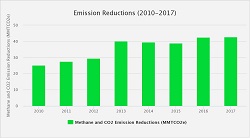Benefits of Landfill Gas Energy Projects
Using landfill gas (LFG) to generate energy and reduce methane emissions produces positive outcomes for local communities and the environment. LFG utilization projects create partnerships among citizens, nonprofit organizations, local governments, and industry in sustainable community planning. The benefits of LFG energy projects are significant for the following reasons.
On this page:
- Reduce Greenhouse Gas Emissions
- Reduce Air Pollution by Offsetting the Use of Non-Renewable Resources
- Create Health and Safety Benefits
- Benefit the Community and Economy
- Reduce Environmental Compliance Costs
Reduce Greenhouse Gas Emissions
Municipal solid waste (MSW) landfills are the third-largest human-generated source of methane emissions in the United States, releasing an estimated 95.6 million metric tons of carbon dioxide (CO2) equivalent (MMTCO2e) to the atmosphere in 2018 alone. With a global warming potential more than 25 times greater than CO2 and a short (12-year) atmospheric life, methane is a potent greenhouse gas that is a key contributor to global climate change. As a result, reducing methane emissions from MSW landfills is one of the best ways to achieve a near-term beneficial impact in mitigating global climate change. In addition, methane contributes to background tropospheric ozone levels as an ozone precursor. Finally, many of the technologies and practices that reduce methane emissions also reduce associated emissions of volatile organic compounds (VOCs), odors, and other local air pollutants.
Given that all landfills generate methane, it makes sense to use the gas for the beneficial purpose of energy generation rather than emitting it to the atmosphere. It is estimated that an LFG energy project will capture roughly 60 to 90 percent of the methane emitted from the landfill, depending on system design and effectiveness. The captured methane is destroyed (converted to water and the much less potent CO2) when the gas is burned to produce electricity. LMOP's LFG Energy Benefits Calculator can be used to estimate greenhouse gas reductions from LFG recovery projects.
CO2 emissions from MSW landfills are not considered to contribute to global climate change because the carbon was contained in recently living biomass. The same CO2 would be emitted as a result of the natural decomposition of the organic waste materials outside the landfill environment.
Reduce Air Pollution by Offsetting the Use of Non-Renewable Resources
Producing energy from LFG offsets the use of non-renewable resources, such as coal, oil, or natural gas, to produce the same amount of energy. This can avoid emissions of CO2, criteria pollutants such as sulfur dioxide (a major contributor to acid rain), particulate matter (a respiratory health concern), and nitrogen oxides (NOX), and trace hazardous air pollutants from power plants and other fossil fuel users.
Like all combustion devices, LFG electricity generation devices emit some NOX, which can contribute to local ozone and smog formation. Depending on the fuels and technologies used by the power plant and the landfill project, the NOX emitted from the LFG electricity project may exceed the avoided NOX emissions from the power plant. Overall, however, LFG electricity generation projects significantly improve the environment because of the significant methane emission reductions, hazardous air pollutant reductions, and avoidance of the use of non-renewable resources such as coal and oil that are more polluting than LFG.
Create Health and Safety Benefits
Burning LFG to produce electricity destroys most of the non-methane organic compounds (including hazardous air pollutants and VOCs) that are present at low concentrations in uncontrolled LFG, which reduces possible health risks from these compounds. In addition, gas collection can improve safety by reducing explosion hazards from gas accumulation in structures on or near the landfill. Generating electricity from existing MSW landfills is also a relatively cost-effective way to provide new renewable energy generation capacity to supply community power needs.
Benefit the Community and Economy
LFG energy projects generate revenue from the sale of the gas. LFG use can also create jobs associated with the design, construction, and operation of energy recovery systems. LFG energy projects involve engineers, construction firms, equipment vendors, and utilities or end users of the power produced. Much of the project costs are spent locally for drilling, piping, construction, and operational personnel, helping communities to realize economic benefits from increased employment and local sales. Local businesses realize cost savings associated with using LFG as a replacement for more expensive fossil fuels. Some companies could save millions of dollars over the life of their LFG energy projects.
By linking communities with innovative ways to deal with their LFG, LMOP helps communities enjoy increased environmental protection, better waste management, and responsible community planning.
Reduce Environmental Compliance Costs
Current EPA regulations under the Clean Air Act require many larger landfills to collect and combust LFG. There are several compliance options, including flaring the gas or installing an LFG use system. Only LFG energy recovery gives communities and landfill owners the opportunity to reduce the costs associated with regulatory compliance by turning pollution into a valuable community resource.

